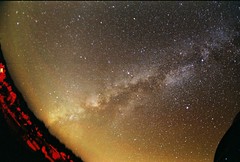
 Zodiacal Light
Zodiacal LightOriginally uploaded by Computer Science Geek
Awesome picture! I've never heard of zodiacal light before today (I know, its embarrassing considering I run an astronomy blog) but I've been checking out some photo's and found these great ones from Computer Science Geek on Flickr. I definitely think this stuff is right up there with aurora and Milky Way photography is terms of coolness (way more important than scientific relevance!).

Zodiacal light is really cool. It basically is light from the Sun reflected back by interplantary dust. To produce this light, according to Wikipedia (which I will choose to trust this time), only a 1mm dust particle every 8 kilometers in space that is equally reflective as the moon can produce this effect.



























 And my newer pic. This one is 7 exposures stacked through Registax, and with adjusted Curves through Photoshop (with a custom diffraction spike brush as well).
And my newer pic. This one is 7 exposures stacked through Registax, and with adjusted Curves through Photoshop (with a custom diffraction spike brush as well).





